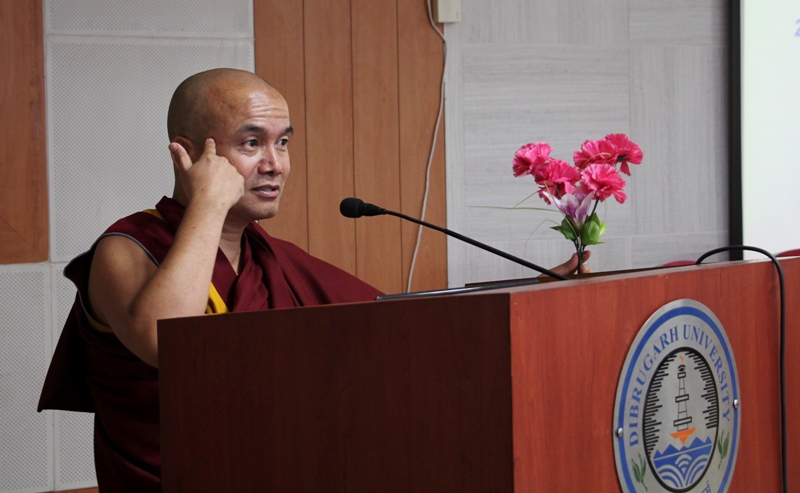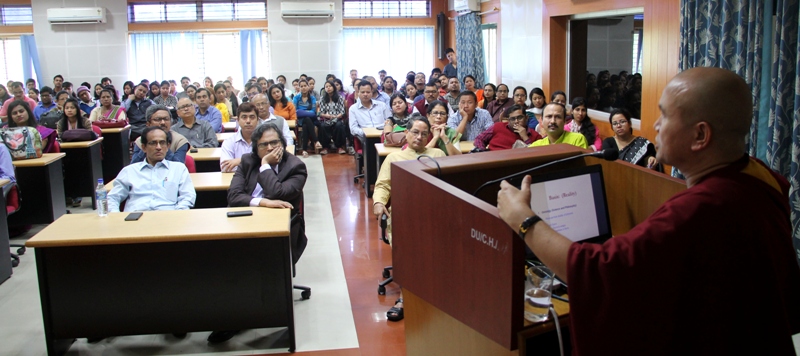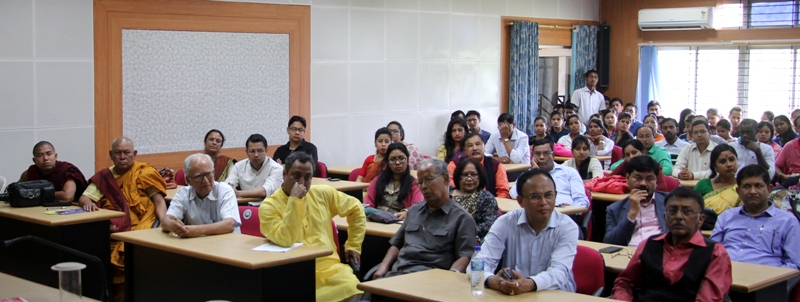

The Buddhist Study Centre, Department of History, Dibrugarh University organized a one day symposium on ‘Parallel Thoughts: Buddhist Philosophy and Modern Science’ on 8th November, 2016. This symposium was part of a series of dialogues on Buddhism and Science to be organized by the Buddhist Centre. The symposium was attended by range of scholars, researchers and students from both science and social science disciplines and the programme was successful in promoting inter-disciplinary dialogue regarding science, social science and Buddhist Philosophy. Professor A. K. Buragohain inaugurated the symposium and he emphasized on promoting the critical spirit within Buddhism which will always help in engaging with developments in science, issues of ethics and secular humanism. Professor Buragohain commented that in spite of great strides in science and technology, issues of social ethics are undermined. According to him, emphasis on innovation exclusively for growth oriented economy has marginalized the importance of healing the hearts without which the contemporary world will end up in self defeating imbroglio engulfing the entire humanity. Here Buddhism, Buddhist ethics and modern scientific spirit can show us new path. Ven. Geshe Dorji Damdul, Director, Tibet House, Cultural Centre of H.H. Dalai Lama graced the occasion and presented the theme lecture. Geshe Dorji Damdul being an erudite scholar of Buddhist philosophy, imbibed with inter-disciplinary skill and aptitude, gave his lecture on Buddhist Philosophy, modern science, Buddhist psychology and neuro-science and finally concluded his lecture on importance of ethical considerations without which the present problems facing the world today can never be addressed in a meaningful way. Stressing the importance of inter-disciplinary research in the present highly inter-connected world, Damdul illustrated how Buddhist philosophy, developments in modern science can be studied together and how this will help in opening up new possibilities transcending the limitations put by conventional disciplinary boundaries. According to him, human beings are psycho-physical complexes consisting of physical bodies and minds, and there is always a need to synthesise scientific wisdom with Buddhist ethics. Regarding modern science and Buddhism, Damdul said that the theory of relativity addresses reality in the form of relativistic world, where both space and time are relative and in Buddhism everything exist relatively and time is no exception. Regarding quantum theory Damdul said that while classical physics maintained the idea more deterministic in nature as opposed to randomness and uncertainty, quantum mechanics rejected it fully by rejecting this new concepts at the level of sub-atomic particles like electrons. Damdul emphasized that quantum theory has a great resemblance with the Buddhist philosophy of dependent origination where everything exists relatively and time is no exception. He mentioned the comment of Raja Raman during a conversation with Dalai Lama where he said, ‘the concept of quantum theory which the scientist discovered for not more than hundred years is what Nagarjuna (2nd century AD), a Buddhist master has already elucidated so well since thousand years ago'. Damdul in his presentation also emphasized how Buddhist psychology and recent developments in neuro-science can be better contextualised if it is illuminated by the idea of parallel thoughts where disciplines explore one another; find out their convergences and divergences. Towards the end of his lecture, Damdul stressed on the of ethics and secular humanism to face the problems of contemporary world compounded by unethical use of technological breakthroughs. Here Buddhist ethics, scientific temper and concern for larger humanity can bring us a new global perspective. He enthralled the audience by his powerful speech and eloquence.

Dr. Rajeshwar Mukherjee, Research Officer, Kaivalyadhama research Institute also presented an illuminating lecture regarding Buddhist Philosophy and modern science in the symposium on ‘Parallel Thoughts: Buddhism and Modern Science’. He began his exposition with the discussion on the synthesis of Modern Science and Eastern Mysticism. Quoting the physicists like Professor Fritjof Capra and Professor Arthur Eddington, he argued that Eastern mysticism, which includes Buddhism, has a great role to play in deriving newer insights in the field of modern science, especially in Physics. He also referred to Ishopanishad to substantiate that the cultivation of both material science and spiritual knowledge simultaneously is the sine qua non of holistic wisdom. He further argued that Lord Buddha was the fulfilment and the logical conclusion of the Vedas. Buddha’s teaching contained the germ of the philosophical wisdom that flourished as Buddhist philosophical systems subsequently. He mentioned about the four Buddhist schools of thought with special reference to the Madhyamika philosophy of the great Buddhist philosopher Nagarjuna. He also argued, on the basis of textual evidence, thatMandukyaKarika of Gaudapada is pregnant with the philosophical tenets of Sunyavada of the Madhyamika school of Buddhism which later culminated in the Advaita Vedanta of Acharya Samkara. Dr. Rajeshwar Mukherjee then added that the Philosophy of Shunya as championed by the Buddhist Scholars has wonderful parallels in the world of physics. He unfolded the nature of Shunya with textual evidence and asserted that the Quantum Vacuum of modern physics is analogous to concept of Shunya as propounded by the Buddhist philosophers. He added that modern researches show that there are evidences of the traces of consciousness in the quantum vacuum. The Buddhist philosophers called the phenomenal world samvriti which is also called shunya as it is devoid of the real essence. Therefore the quantum vacuum which is the substratum of the physical existence may also be called Shunya from the perspective of the theory of Shunya as championed by the Buddhist and the Hindu philosophers.
Professor G.D. Baruah, Former Professor of the Department of Physics, Dibrugarh University also presented his thoughts regarding Buddhist Philosophy and Modern Science in his symposium speech. Professor Baruah’s lecture on the theme started with a quote from Warner Heisenberg, the great quantum physicist, who was of the opinion that in the history of human thinking the most fruitful developments frequently takes place at those points where two different ( but parallel) lines of thought meet. Heisenberg’s view was illustrated in the talk which was divided into five different sections. Some important areas which were highlighted in the lecture included space, time , space-time, entropy., vacuum fluctuation, quantum mechanics, Big Bang, expanding universe and spectral line. Personalities such as Newton, Einstein, Hawkings, Lord Buddha also found emphasis in the talk. In the beginning the space and time was defined and it was clearly described how space and time were actually not different but belong to the same space-time continuum of the four dimensional universe. It was also described how Einstein formulated his special theory of relativity by identifying time as the prime suspect. Apart from four dimensional universe the topic which was given prime importnance was the direction of time, that is in which direction the time is flowing. Using the work of Stephen Hawkings, published in 1985, it was shown that the universe we live in appears to be symmetric in time. Based on this concept the three directions of time, which are psychological arrows of time, the thermodynamic arrow of time and the cosmological arrows of time, they are all shown to be pointed in the same direction. That is the direction of the expanding universe (currently accelerating). The topic which was given adequate emphasis is the so called vacuum fluctuation. It was described how vacuum fluctuation is identical to the idea of ultimate reality, Sunyata-Emptiness and Void, which is present in the Buddhist and other eastern philosophies.
In the concluding part of the speech a parallel was drawn between the real Quantum World and the Buddhist philosophy. Specifically it was shown that Buddha had given answers when interrogated as to the condition of the many self after death, in the language of quantum mechanics only.
Rev. Pragyasara in his brief presentation commented on the symposium lectures. Dr. Chandan Syam also commented on the theme lectures of the programme.The programme ended with vote of thanks presented by Chandan Kumar Sarma, Coordinator, Buddhist Studies Centre, Dibrugarh University.
